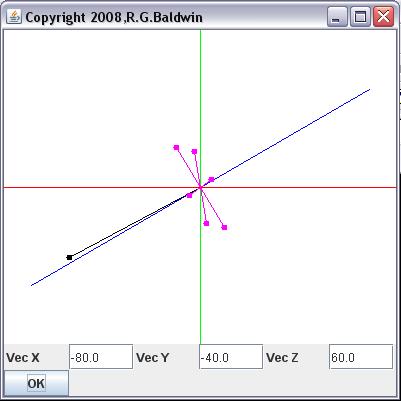| << Chapter < Page | Chapter >> Page > |
Although the documentation doesn't provide much in the way of explanatory text (see Listing 8 and the explanations given above) , the documentation does provide a good overview of the organization and structure ofthe library. You may find it helpful in that regard.
The homework assignment for this module was to study the Kjell tutorial through Chapter 10, Angle between 3D Vectors .
The homework assignment for the next module is to continue studying that same material.
In addition to studying the Kjell material, you should read at least the next two modules in this collection and bring your questions about that material tothe next classroom session.
Finally, you should have begun studying the physics material at the beginning of the semester and you should continue studying one physics moduleper week thereafter. You should also feel free to bring your questions about that material to the classroom for discussion.
I encourage you to copy the code from Listing 8 through Listing 12 . Compile the code and execute it in conjunction with the game-math library named GM02 provided in Listing 8 . Experiment with the code, making changes, and observing the results of your changes. Make certain that youcan explain why your changes behave as they do.
In this module, you learned the fundamentals of the vector dot product in both 2D and 3D. You learned how to update the game-math library to supportvarious aspects of the vector dot product, and you learned how to write 2D and 3D programs that use the vector dot product methods in the game-math library.
In the next module, which will be the second part of this two-part miniseries on the vector dot product, you will learn how to use thedot product to compute nine different angles of interest that a vector makes with various elements in 3D space.
You will learn how to use the dot product to find six of the infinite set of vectors that are perpendicular to a given vector as shown in Figure 16 .
Figure 16 Six (magenta) vectors that are perpendicular to a given (black) vector.

You will also learn how to use the dot product to perform back-face culling as shown in Figure 1 and Figure 2 .
This section contains a variety of miscellaneous information.
Financial : Although the Connexions site makes it possible for you to download a PDF file for thismodule at no charge, and also makes it possible for you to purchase a pre-printed version of the PDF file, you should beaware that some of the HTML elements in this module may not translate well into PDF.
I also want you to know that, I receive no financial compensation from the Connexions website even if you purchase the PDF version of the module.
In the past, unknown individuals have copied my modules from cnx.org, converted them to Kindle books, and placed them for sale on Amazon.com showing me as the author. Ineither receive compensation for those sales nor do I know who does receive compensation. If you purchase such a book, please beaware that it is a copy of a module that is freely available on cnx.org and that it was made and published withoutmy prior knowledge.
Affiliation : I am a professor of Computer Information Technology at Austin Community College in Austin, TX.

Notification Switch
Would you like to follow the 'Game 2302 - mathematical applications for game development' conversation and receive update notifications?